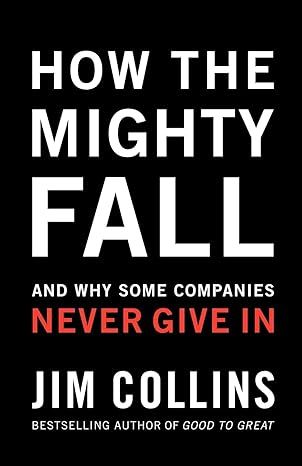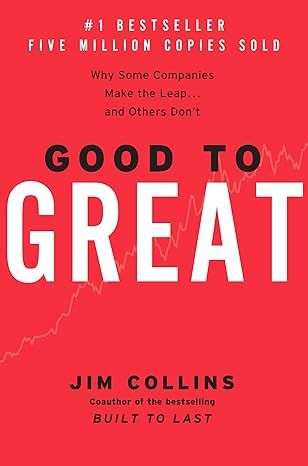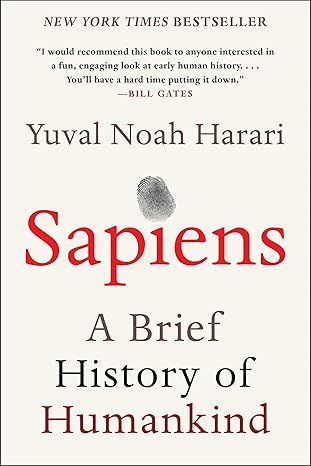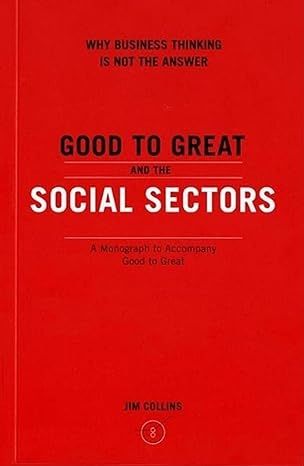Good to Great and the Social Sectors: A Monograph to Accompany Good to Great (Good to Great, 3)
4.5 out of 5
1,474 global ratings
Jim Collins Answers the Social Sector with a Monograph to Accompany Good to Great. 30-50% of those who bought Good to Great work in the Social Sector.
- This monograph is a response to questions raised by readers in the social sector. It is not a new book.
- Jim Collins wants to avoid any confusion about the monograph being a book by limiting its distribution to online retailers.
- Based on interviews and workshops with over 100 social sector leaders.
- The difference between successful organizations is not between the business and the social sector, the difference is between good organizations and great ones.
35 pages,
Kindle
Paperback
Audio CD
First published November 21, 2005
ISBN 9780977326402
About the authors
Jim Collins
Jim Collins is a student and teacher of what makes great companies tick, and a Socratic advisor to leaders in the business and social sectors. Having invested more than a quarter century in rigorous research, he has authored or coauthored a series of books that have sold in total more than 10 million copies worldwide. They include Good to Great, the #1 bestseller, which examines why some companies make the leap and others don’t; the enduring classic Built to Last, which discovers why some companies remain visionary for generations; How the Mighty Fall, which delves into how once-great companies can self-destruct; and Great by Choice, which uncovers the leadership behaviors for thriving in chaos and uncertainty. Jim has also published two monographs that extend the ideas in his primary books: Good to Great and the Social Sectors and Turning the Flywheel.
His most recent publication is BE 2.0 (Beyond Entrepreneurship 2.0), an ambitious upgrade of his very first book; it returns Jim to his original focus on small, entrepreneurial companies and honors his coauthor and mentor Bill Lazier.
Driven by a relentless curiosity, Jim began his research and teaching career on the faculty at the Stanford Graduate School of Business, where he received the Distinguished Teaching Award in 1992. In 1995, he founded a management laboratory in Boulder, Colorado, where he conducts research and engages with CEOs and senior-leadership teams.
In addition to his work in the business sector, Jim has a passion for learning and teaching in the social sectors, including education, healthcare, government, faith-based organizations, social ventures, and cause-driven nonprofits. In 2012 and 2013, he had the honor to serve a two-year appointment as the Class of 1951 Chair for the Study of Leadership at the United States Military Academy at West Point.
Jim holds a bachelor's degree in mathematical sciences and an MBA from Stanford University, and honorary doctoral degrees from the University of Colorado and the Peter F. Drucker Graduate School of Management at Claremont Graduate University. In 2017, Forbes selected Jim as one of the 100 Greatest Living Business Minds.
Read more
Reviews
Angela
5
He outlines the steps these institutions took to separate them from the good and made them truly great
Reviewed in the United States on July 28, 2015
Verified Purchase
As someone who is finishing his undergraduate career, I found this monologue not only to be inspiring, but also helpful as I prepare to enter the workforce. I am interested in becoming involved in or starting a nonprofit, and I don’t think I could’ve gotten the concepts offered in this book anywhere else. In short, I felt empowered. In the monograph, Collins wrote that over the years he recognized that many business leaders entered into the social sector only to encounter failure. Seeking to solve this, he researched and compared successful businesses and social sector institutions to see what common elements made them survive—and where they fell. He outlines the steps these institutions took to separate them from the good and made them truly great. This research birthed Good to Great, and the monologue stands as a piece addressed to the hopeful social sector leaders amongst its readers. Its overall message seems to read, “Greatness isn’t what you might think it is, and here is how to achieve it.”
Jim Collin’s writing is at once entertaining and clear. Even a junior high schooler could pick up his this piece and follow his logical and fluid wiring. His natural language and purposeful strut drew me in from the first page. Even though this was an accompanying monologue to Good to Great, he quickly ‘caught me up’ to the concepts presented in the book, relating them directly to the plight of the social sector. I was stunned by the clear comparisons in thinking that he drew between successful social sector institutions and businesses. In five very clear sections, Collins addresses separate issues that social sector leaders must address to form a successful social sector institution. They are as follows:
-
“Defining “Great,”—Calibrating Success Without Business Metrics,”
-
“Level 5 Leadership—Getting Things Done within a Diffuse Power Structure”
-
“First Who—Getting The Right People On The Bus, Within Social Sector Constraints.”
-
“The Hedgehog Concept—Rethinking the Economic Engine without a Profit Motive”
-
“Turning the Flywheel—Building Momentum by Building the Brand”
Each section’s issue addresses very important questions. For the social sectors, the first answers how greatness can be defined and pursued, the second helps show what extremely adept and effective leaders look like, the third helps show how to hire the right people, the fourth focuses on both on sustaining longevity and consistency, and the fifth talks about how to build momentum and create a bigger impact within the communities touched by a ‘social sector.’ In each issue, Collins uses real-world examples of great leaders and the decisions they made to steer their organizations towards greatness. From Tom Morris of the Cleveland Orchestra to William Bratton of the NYPD, a variety of examples edify Collins’ concepts. Combined with graphs and empirical data, his narrative walks the reader through the various hurtles faced by social sectors and businesses alike, and shows how a social sector responds to prevail and achieve greatness, from day one. Readers of this book will learn how to lead (and when not to,) how to measure success, how to recruit, how to find corporate purpose, how to rethink resources, and how to overcome crises.
I think that calling this book ‘a manual solely for social sector leaders’ would not do its utility or its masterful breadth of coverage justice, even for its 31 page length. Collins eloquently nails ideas usually learned over years of trial-and-error. The monograph is testament to the genius of Collins and Good to Great, and the practical wisdom provided inside is more than worth its time. Jim Collins has provided the missing link for many who seek to venture into nonprofit careers or business. I would recommend this book to students and professionals alike, for the skills presented in this monologue. This book, in short, teaches you how to lead a team of people towards making an impact in a way that ethically utilizes resources and personnel, and sustain performance towards a state of accomplishment aforementioned as ‘great.’ I would highly recommend this book to you if you plan to run or organize a nonprofit.
Read more
15 people found this helpful
Todd Iverson
5
Fantastic addendum to his book for business.
Reviewed in the United States on September 6, 2022
Verified Purchase
Non-profits are by definition a different animal than the businesses that Collins is an expert on. Apparently, he's an expert on non-profits too, highlighting the key differences in the processes and outcomes between the two. Essential reading still after all these years. I loaned my last copy out and needed to get a new one. Funny how that happens so often with this title.
Read more
2 people found this helpful
Chad Stuart
5
Great Insights for Pastors and Their Teams
Reviewed in the United States on July 17, 2023
Verified Purchase
I read Good to Great years ago but I am grateful for these monographs that Collins has produced to summarize key aspects of that great work. This monograph in particular is helpful because Collins identifies some unique aspects of working in the social sector.
Helen Stucky Risdon
5
Quick read very useful concept
Reviewed in the United States on February 14, 2014
Verified Purchase
What a happy mistake to receive this monograph book when I thought I was ordering his original Good to Great book! It is very short and easy read that fits the Social Sector and shows how we are different from the business sector. It gave me hope for the Wellness Weavers paradigm. Jim wrote it in a way that would have still made sense to me without reading the main book first.
The only thing that will make this book more effective is finding the Core Team for your pure-in-heart mission. I recommend you get it, apply it and together the social sectors, that are used to stretching our money and leveraging our resources, can transform the world.
The application of this book can help families, communities, businesses, the social sectors work together to solve water, food, healthy communication and collaboration so people can actually realize there is enough for everyone and live with peaceful security. By doing so we can tap into wise use of the tax dollars we have already spent and shape a government that is working for all people.
Read more

William Cooke
5
It's always about the mission.
Reviewed in the United States on February 25, 2011
Verified Purchase
It's the mission ...the mission ...the mission.
What distinguishes a good company from a great company? If you're in the private sector, chances are that your answer is profit, return-on-investment (ROI). In 1972, $10,000 invested in Southwest Airlines would be worth $10 million thirty years later; if you invested in Pan Am.... In the social sector, what makes an organization great is its performance relative to its mission.
"Good to Great and the Social Sectors" builds on Jim Collins' earlier work and is a standalone monograph for those whose business it is to serve. No doubt, some principles of management transcend sector but some do not. How do you harness the power of individual volunteers to achieve greatness when no one even has to show up? How do you motivate (and retain) a staff that is not working solely for the money? How do you create and maintain an organizational culture that stubbornly, resolutely, persists in the face of uncertainty, when you and the individuals you serve are not valued as much as when times were good?
In today's world, budgets for government agencies and funding streams for voluntary providers are in doubt. At the most prosperous moment in human history, we are experiencing class warfare like never before. The American taxpayer is "mad as Hell and not gonna take it anymore" ...as if "it" was cruel exploitation taken while the taxpayer was distracted --presumably watching an episode of The Simpsons. Sadly, many politicians are reacting in kind. For a social sector organization to navigate in hostile waters, it had better be thinking about its mission.
"Good to Great and the Social Sectors" is a guide for leaders of organizations that care about people, but it is also realistic about what it takes to become GREAT. After all, that's the point. It will help you focus, organize, and value those in your organization who have a desire to give meaning to one's life. It will help you assess the turf and build your brand; "anyone seeking to cut funding must contend with the brand".
Jim Collins says, "If we only have great companies, we will merely have a prosperous society, not a great one. Economic growth and power are the means, not the definition, of a great nation." Bravo!
Read more
Kindle Customer
5
Lots of info in a short space
Reviewed in the United States on January 6, 2024
Verified Purchase
Straight talk, to the point about reframing one's perspective around non-profit and business model differences. Wish I'd read this long ago.
Bubble Metropolis
4
Refreshing Perspective
Reviewed in the United States on June 1, 2024
Verified Purchase
Good to Great and the Social Sectors challenges traditional thinking by exploring the applicability of business concepts to social challenges. While insightful and well-written, it falls short of addressing all complexities. Still, it offers practical strategies and empowers social sector leaders to navigate their unique landscape effectively. Recommended for those seeking innovative approaches to driving social change.
Read more
Jeremy Haggard
4
Great addendum to the original Good to Great!
Reviewed in the United States on August 22, 2011
Verified Purchase
Anyone who's read Good to Great will know that the original book is full of great stories about how businesses went from simply being "good" to being "great." Though some of these companies are not held in the same high esteem they were when Jim Collins wrote the original (Circuit City or Fannie Mae, anyone?) -- the observations he took from those companies are still valid today.
The missing piece from Good to Great is how to make the original work for organizations that don't have the bottom line as the driving factor. Nonprofits still need to have "the right people on the bus," "Level 5 Leadership," and need to have a "hedgehog," but Collins didn't tell us how these applied to the non-business sector.
This problem is addressed in this small add-on -- Good to Great and the Social Sectors, a small read that makes it clear on how nonprofits can still apply Good to Great values to their own organizations with mission -- not profit -- in mind. This work doesn't stand on its own, however; one must read the original book to understand the principles in-depth so they'll make sense when the reader comes upon them in Good to Great and the Social Sectors.
As one of the best business and leadership books of the past decade, From Good to Great is a must-read for any for-profit or nonprofit executive, but the latter would be more easily guided in how those principles will work for them in this very reasonably priced followup.
Read more
5 people found this helpful
Aaron M. Marcelli
4
Good Content But Does Not Stand Alone
Reviewed in the United States on February 29, 2016
Verified Purchase
I am the financial leader for our small nonprofit organization. As I was getting my MBA, I was constantly making the adjustments in my mind to make the business content fit our nonprofit world. I did the same while reading Good To Great a couple years ago. Still, I was glad to see Collins had produced this monograph written specifically relating to the social sectors.
The booklet is only 35 pages long, and, as he says in the intro, was originally intended to be an additional chapter in GTG. It fit that format, clearly drawing on the principles of GTG, while specifically identifying some of the unique factors in the social sector that call for adjustments to the principles (such as “economic engine” becoming “resource engine.”
If you have not read Good To Great, you may not be able to simply pick up this monograph and easily follow along. As noted, it was meant to be an additional chapter to the book. So while there is some overview of the Good to Great principles given, the writing clearly expects you to be familiar with the content of the full book.
And though I appreciate the attention Collins gives to the social sector (something few business experts do), he also indicated he may not be quite as engaged in this field. At one point he states his team was not very motivated to do research into the social sector in the same way they did in their business analytics, and later states further research may reveal differing conclusions, indicating theirs was not very extensive.
However, if you have read Good To Great and work within the social or nonprofit world, I recommend the book. The content will spark thought and the final section on building pockets of greatness is worth the price alone. As the thesis for the monograph states, it’s not about a language/culture of for-profit and nonprofit, but of greatness, and that can be done in any field or sector.
Read more
10 people found this helpful
healthier
3
This is not the full book, but rather a monograph
Reviewed in the United States on May 20, 2021
Verified Purchase
If you are looking for the book, Good to Great, this is not it. It is a monograph. To Jim Collins own point in his introduction, the material in this monograph was intended as a new chapter when the book reprinted, but he decided to sell it as a stand-along but complementary to the book. Just a FYI.
Top Jim Collins titles

Turning the Flywheel: A Monograph to Accompany Good to Great
4.6
-
1,230
$0.99

How The Mighty Fall
4.6
-
1,081
$0.99

BE 2.0 (Beyond Entrepreneurship 2.0): Turning Your Business into an Enduring Great Company
4.8
-
803
$0.99

Great by Choice: Uncertainty, Chaos and Luck - Why Some Thrive Despite Them All
4.6
-
1,765
$0.99

Good to Great: Why Some Companies Make the Leap...And Others Don't (Good to Great, 1)
4.5
-
9,099
$0.99
Best Sellers

The Tuscan Child
4.2
-
100,022
$8.39

The Thursday Murder Club: A Novel (A Thursday Murder Club Mystery)
4.3
-
155,575
$6.33

Sapiens: A Brief History of Humankind
4.6
-
140,302
$13.49

The Butterfly Garden (The Collector, 1)
4.3
-
88,556
$9.59

Things We Hide from the Light (Knockemout Series, 2)
4.4
-
94,890
$11.66

The Last Thing He Told Me: A Novel
4.3
-
154,085
$2.99

The Perfect Marriage: A Completely Gripping Psychological Suspense
4.3
-
143,196
$9.47

The Coworker
4.1
-
80,003
$13.48

First Lie Wins: A Novel (Random House Large Print)
4.3
-
54,062
$14.99

Mile High (Windy City Series Book 1)
4.4
-
59,745
$16.19

Layla
4.2
-
107,613
$8.99

The Locked Door
4.4
-
94,673
$8.53

